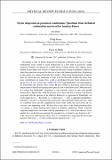| dc.contributor.author | Daou, Joel | |
| dc.contributor.author | Pearce, Philip | |
| dc.contributor.author | Al-Malki, Faisal | |
| dc.date.accessioned | 2018-03-27T14:25:56Z | |
| dc.date.available | 2018-03-27T14:25:56Z | |
| dc.date.issued | 2018-02 | |
| dc.date.submitted | 2017-10 | |
| dc.identifier.issn | 2469-990X | |
| dc.identifier.issn | 2469-9918 | |
| dc.identifier.uri | http://hdl.handle.net/1721.1/114385 | |
| dc.description.abstract | We present a study of Taylor dispersion in premixed combustion and use it to clarify fundamental issues related to flame propagation in a flow field. In particular, simple analytical formulas are derived for variable density laminar flames with arbitrary Lewis number Le providing clear answers to important questions arising in turbulent combustion, when these questions are posed for the case of one-scale laminar parallel flows. Exploiting, in the context of a laminar Poiseuille flow model, a thick flame distinguished asymptotic limit for which the flow amplitude is large with the Reynolds number Re fixed, three main contributions are made. First, a link is established between Taylor dispersion [G. Taylor, Proc. R. Soc. London Ser. A 219, 186 (1953)] and Damköhler's second hypothesis [G. Damköhler, Ber. Bunsen. Phys. Chem. 46, 601 (1940)] by describing analytically the enhancement of the effective propagation speed U[subscript T] due to small flow scales. More precisely, it is shown that Damköhler's hypothesis is only partially correct for one-scale parallel laminar flows. Specifically, while the increase in U[subscript T] due to the flow is shown to be directly associated with the increase in the effective diffusivity as suggested by Damköhler, our results imply that U[subscript T] ∼ Re (for Re ≫ 1) rather than U[subscript T] ∼ √Re, as implied by Damköhler's hypothesis. Second, it is demonstrated analytically and confirmed numerically that, when U[subscript T] is plotted versus the flow amplitude for fixed values of Re, the curve levels off to a constant value depending on Re. We may refer to this effect as the laminar bending effect as it mimics a similar bending effect known in turbulent combustion. Third, somewhat surprising implications associated with the dependence of U[subscript T] and of the effective Lewis number Le[subscript eff] on the flow are reported. For example, Le[subscript eff] is found to vary from Le to Le[superscript −1] as Re varies from small to large values. Also, U[subscript T] is found to be a monotonically increasing function of Re if Le < √2 and a nonmonotonic function if Le > √2. | en_US |
| dc.publisher | American Physical Society | en_US |
| dc.relation.isversionof | http://dx.doi.org/10.1103/PhysRevFluids.3.023201 | en_US |
| dc.rights | Article is made available in accordance with the publisher's policy and may be subject to US copyright law. Please refer to the publisher's site for terms of use. | en_US |
| dc.source | American Physical Society | en_US |
| dc.title | Taylor dispersion in premixed combustion: Questions from turbulent combustion answered for laminar flames | en_US |
| dc.type | Article | en_US |
| dc.identifier.citation | Daou, Joel, Philip Pearce, and Faisal al-Malki . “Taylor Dispersion in Premixed Combustion: Questions from Turbulent Combustion Answered for Laminar Flames.” Physical Review Fluids, vol. 3, no. 2, Feb. 2018. © 2018 American Physical Society | en_US |
| dc.contributor.department | Massachusetts Institute of Technology. Department of Mathematics | en_US |
| dc.contributor.mitauthor | Pearce, Philip | |
| dc.relation.journal | Physical Review Fluids | en_US |
| dc.eprint.version | Final published version | en_US |
| dc.type.uri | http://purl.org/eprint/type/JournalArticle | en_US |
| eprint.status | http://purl.org/eprint/status/PeerReviewed | en_US |
| dc.date.updated | 2018-02-14T18:00:50Z | |
| dc.language.rfc3066 | en | |
| dc.rights.holder | American Physical Society | |
| dspace.orderedauthors | Daou, Joel; Pearce, Philip; Al-Malki, Faisal | en_US |
| dspace.embargo.terms | N | en_US |
| mit.license | PUBLISHER_POLICY | en_US |
